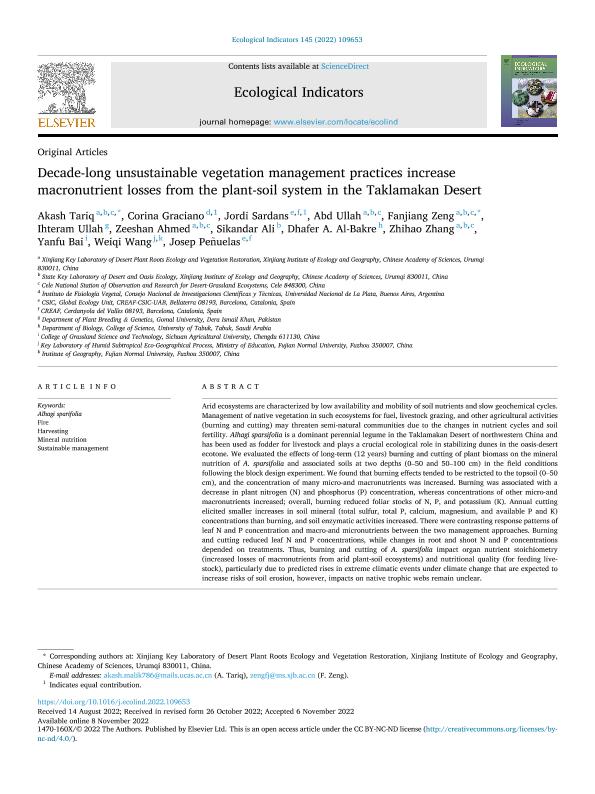Artículo
Decade-long unsustainable vegetation management practices increase macronutrient losses from the plant-soil system in the Taklamakan Desert
Tariq, Akash; Graciano, Corina ; Sardans, Jordi; Ullah, Abd; Zeng, Fanjiang; Ullah, Ihteram; Ahmed, Zeeshan; Ali, Sikandar; Al Bakre, Dhafer A.; Zhang, Zhihao; Bai, Yanfu; Wang, Weiqi; Peñuelas, Josep
; Sardans, Jordi; Ullah, Abd; Zeng, Fanjiang; Ullah, Ihteram; Ahmed, Zeeshan; Ali, Sikandar; Al Bakre, Dhafer A.; Zhang, Zhihao; Bai, Yanfu; Wang, Weiqi; Peñuelas, Josep
 ; Sardans, Jordi; Ullah, Abd; Zeng, Fanjiang; Ullah, Ihteram; Ahmed, Zeeshan; Ali, Sikandar; Al Bakre, Dhafer A.; Zhang, Zhihao; Bai, Yanfu; Wang, Weiqi; Peñuelas, Josep
; Sardans, Jordi; Ullah, Abd; Zeng, Fanjiang; Ullah, Ihteram; Ahmed, Zeeshan; Ali, Sikandar; Al Bakre, Dhafer A.; Zhang, Zhihao; Bai, Yanfu; Wang, Weiqi; Peñuelas, Josep
Fecha de publicación:
12/2022
Editorial:
Elsevier Science
Revista:
Ecological Indicators
ISSN:
1470-160X
Idioma:
Inglés
Tipo de recurso:
Artículo publicado
Clasificación temática:
Resumen
Arid ecosystems are characterized by low availability and mobility of soil nutrients and slow geochemical cycles. Management of native vegetation in such ecosystems for fuel, livestock grazing, and other agricultural activities (burning and cutting) may threaten semi-natural communities due to the changes in nutrient cycles and soil fertility. Alhagi sparsifolia is a dominant perennial legume in the Taklamakan Desert of northwestern China and has been used as fodder for livestock and plays a crucial ecological role in stabilizing dunes in the oasis-desert ecotone. We evaluated the effects of long-term (12 years) burning and cutting of plant biomass on the mineral nutrition of A. sparsifolia and associated soils at two depths (0–50 and 50–100 cm) in the field conditions following the block design experiment. We found that burning effects tended to be restricted to the topsoil (0–50 cm), and the concentration of many micro-and macronutrients was increased. Burning was associated with a decrease in plant nitrogen (N) and phosphorus (P) concentration, whereas concentrations of other micro-and macronutrients increased; overall, burning reduced foliar stocks of N, P, and potassium (K). Annual cutting elicited smaller increases in soil mineral (total sulfur, total P, calcium, magnesium, and available P and K) concentrations than burning, and soil enzymatic activities increased. There were contrasting response patterns of leaf N and P concentration and macro-and micronutrients between the two management approaches. Burning and cutting reduced leaf N and P concentrations, while changes in root and shoot N and P concentrations depended on treatments. Thus, burning and cutting of A. sparsifolia impact organ nutrient stoichiometry (increased losses of macronutrients from arid plant-soil ecosystems) and nutritional quality (for feeding livestock), particularly due to predicted rises in extreme climatic events under climate change that are expected to increase risks of soil erosion, however, impacts on native trophic webs remain unclear.
Palabras clave:
ALHAGI SPARIFOLIA
,
FIRE
,
HARVESTING
,
MINERAL NUTRITION
,
SUSTAINABLE MANAGEMENT
Archivos asociados
Licencia
Identificadores
Colecciones
Articulos(INFIVE)
Articulos de INST.DE FISIOLOGIA VEGETAL
Articulos de INST.DE FISIOLOGIA VEGETAL
Citación
Tariq, Akash; Graciano, Corina; Sardans, Jordi; Ullah, Abd; Zeng, Fanjiang; et al.; Decade-long unsustainable vegetation management practices increase macronutrient losses from the plant-soil system in the Taklamakan Desert; Elsevier Science; Ecological Indicators; 145; 12-2022; 1-11
Compartir
Altmétricas



